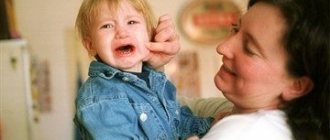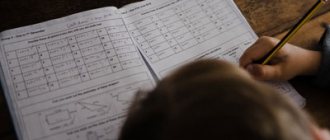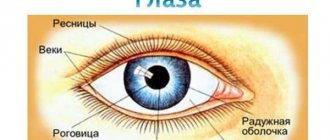The gene theory of origin links early childhood autism with genetic defects. It is known that 2% of autistic offspring also suffer from this disorder; the probability of having a second autistic child in a family is 9%, which is many times higher than the average population frequency.
The teratogenic theory of early childhood autism says that various exogenous and environmental factors affecting the body of a pregnant woman in the early stages can cause biological damage to the fetal central nervous system and subsequently lead to disruption of the child’s overall development. Teratogens can be food components, such as preservatives, stabilizers, nitrates, as well as alcohol, nicotine, drugs, medications, intrauterine infections, stress, environmental factors such as radiation, exhaust gases, heavy metal salts.
Alternative theories link the origin of early childhood autism with fungal infection, metabolic, immune and hormonal disorders, and older age of parents.
Symptoms
Early childhood autism syndrome becomes apparent by the age of three, but signs of autism can be detected during infancy. Main symptoms:
- the “revitalization complex” characteristic of infants is disrupted. The baby has practically no reaction to external stimuli: light, the sound of a rattle, etc., later he begins to recognize his parents as peers and does not show affection for them;
- the child averts his eyes to the side, his gaze absent;
- Gesture in children differs from usual and may be completely absent;
- avoids the touch of people, even parents;
- possible refusal of mother's milk;
- there is a delay in speech development, speech is monotonous, unemotional;
- increased anxiety;
- Accelerated growth of head circumference may be observed.
Little autistic children, compared to normal children, may have talent in narrow areas, since other areas are closed to them due to the peculiarities of brain development. They are more attentive and diligent.
With the need to enter society, the signs of the disease become more obvious; in the absence of correction, a person’s isolation grows over the years.
Symptoms of Kanner's syndrome
Clinical picture of autism: 1 - cerebral cortex;
2 - corpus callosum; 3 - cerebellum; 4 - brain stem; 5 - tonsil; 6 - hypothalamus; 7 - basal ganglia Below is a relatively detailed description of the symptoms of the disorder:
- Children suffering from Kanner syndrome are usually not interested in sharing personal joys or sorrows with their peers. Typically, these children have difficulty maintaining friendships with other children. They are critical of non-verbal communication. People with autism avoid eye contact, cannot interpret facial expressions, and cannot change their posture. There is a lack of ability to empathize with others or understand their emotions.
- Kanner's autism can lead to problems that directly relate to verbal or nonverbal communication. In such children, speech development is significantly inhibited. Even those children who have managed to master speech usually have difficulty starting a conversation and are unable to continue the discussion. Repeating words or phrases that are inappropriate to the topic of conversation is a characteristic behavior of such children.
- Apathy to action is common in children with Kanner syndrome. It is alien to them to engage in activities or games that traditionally interest ordinary children of the same age. A child with a disorder may be attracted to a particular part of a toy, but not to the entire toy. He is able to devote all his time to this part, completely ignoring the other components.
- Sufferers of Kanner syndrome prefer to stick to a stable routine and resist any changes. Problems associated with throwing tantrums and being reckless are common in children with this disorder.
Basic signs of the early stage
There are several basic indications and signs of Kanner's autism that can be detected early in a child's life. If you detect them in time, there is a chance to really help the patient in all possible ways.
For example, speech retardation or slow speech, which is a common symptom of the disorder, should raise alarm bells for parents.
Another detail that is a clear sign of Kanner’s autism in children is the pronounced repetition of movements in a specific part of the body.
Regardless of whether the body part is the head, leg, or arm, repetitive, monotonous movements are seen as a clear sign of Kanner's syndrome.
Understanding the background changes as well as the signs of autism is important in helping these patients cope with the disorder.
Currently, Kanner syndrome affects a significant portion of the world's population. This is an alarming fact that parents or guardians raising children must understand.
Spinner - toy or treatment
For almost the entire period of 2021, a simple toy called a spinner enjoyed high popularity in society. It is noteworthy that a huge number of medical and public publications at various levels paid attention to spinners of various designs throughout the year.
It’s easy to make a toy like this one using simple available materials with your own hands. Below is a link to the paper spinner project
The authors of the publications claim the significant benefits of the spinner as a therapeutic agent for people suffering from anxiety disorders, including Kanner's autism. The practice of medical procedures using spinners in some cases has shown effective results, according to the statements of some doctors.
However, not all doctors practicing in this area agree with such statements. Many people consider fidget spinners to be a useless toy that distracts attention rather than helps them concentrate.
Therefore, if we consider mental health factors, this tool may be effective to some extent. As for Kanner's syndrome, the benefits of fidget spinners have not been studied at the laboratory level, and therefore remain questionable.
Diagnostics
According to the international classification of diseases ICD-10, the diagnostic criteria for early childhood autism are impaired social interaction, impaired communication and stereotypic behavior, interests and activities.
The diagnosis of early childhood autism is established after a period of observation of the child by a collegial commission consisting of a pediatrician, child psychologist, child psychiatrist, child neurologist, speech therapist and other specialists. Various questionnaires, instructions, tests for measuring the level of intelligence and development are widely used.
A clarifying examination may include an EEG, MRI, CT scan of the brain for convulsive syndrome; genetic consultation and genotyping for neurogenetic disorders; consultation with a gastroenterologist for digestive disorders, etc.
Differential diagnosis of early childhood autism is carried out both within the group of pervasive developmental disorders and with other psychopathological syndromes - mental retardation, mental retardation, schizophrenia, deprivation disorders, etc.
Treatment
Cure for early childhood autism syndrome is currently impossible, so drug correction is based on the syndromic principle: if necessary, anticonvulsants, psychostimulants, antipsychotics, etc. are prescribed. There is information about the favorable results of electroacupuncture.
The feasibility of using various experimental techniques (for example, treating early childhood autism with a gluten-free diet) does not have clinically reliable evidence.
The main role in the treatment of early childhood autism is given to:
- psychotherapy;
- psychological and pedagogical correction;
- defectological assistance;
- classes with a speech therapist.
When working with autistic children, music therapy, art therapy, play therapy, hippotherapy, dolphin therapy, occupational therapy, and logorhythmics are used. In the process of teaching autistic children, teachers should focus on the child’s strengths (focus on learning, predominant interests, abilities in exact sciences or languages).
Early childhood autism and basic methods of its correction article
EARLY CHILDHOOD AUTISM AND BASIC METHODS FOR ITS CORRECTION
Abstract: This article discusses the concept and signs of early childhood autism. The processes of formation of individual areas of activity in children with early childhood autism are described, and methods for correcting early childhood autism are also presented.
Key words: early childhood autism (ECA), autism, methods of correction of early childhood autism.
In the modern world, the number of children with neurological pathologies, including early childhood autism, is increasing every year (3-4 cases per 10,000 children in Russia) [5]. Moreover, these deviations are observed more often in boys than in girls.
Despite such fairly extensive data, specialists pay insufficient attention to the study and correction of this disease. In Russia there are no specialized centers for working with children with EDA syndrome, and therefore teachers and parents working with children of this category are forced to independently investigate the issue of the development of a child with early childhood autism.
The term “autism” was introduced at the beginning of the 20th century by the German psychiatrist E. Bleuler, who described it as: “a symptom of schizophrenia, expressed in a special immersion “in the world of dreams,” unreal, invented, which is more real for the patient than the world around him” [ 2, p. 73].
V.M. Bashina understands early childhood autism as: “one of the most complex types of mental development disorders, which belongs to the group of comprehensive disorders, manifested in a comprehensive impairment of mental development: cognitive, manifested in a comprehensive impairment of mental development: cognitive, emotional and sensory spheres” [1, p. . 36].
The syndrome of early childhood autism is finally formed by the age of 3. In early childhood autism, the nature of functional limitations manifests itself in three main areas: social, communicative, motivational [7, p. 101].
Signs of early childhood autism are manifested in the following: avoidance of eye contact, impaired speech development, immaturity of communication skills, monotonous actions in behavior, low expression of imitation, lack of desire to be in the arms of the mother and low ability to express emotions [1, p. 93].
For a child with RDA, contact with an adult is attractive, but social stimulation is not within his range of comfort. For example, the first smile that appears in a baby with autism is not addressed to adults, but arises only as a reaction to the approach of an adult, and to a series of pleasant impressions for the child. Children with autism do not know how to differentiate the emotional states of others, they simply do not need it [6, 54].
Children with signs of early childhood autism, instead of developing interest and active interaction with the world, develop protected mechanisms from entering the social environment. When interacting, such children maintain an inadequate distance; there is no system of positive selectivity. Children with early childhood autism syndrome focus their attention on numerous fears, prohibitions, rituals and protective actions in order to prevent danger [8, p. 215]. Extremely large differences in intellectual development, features of sensory development (hypo- or hypersensitivity), complex speech disorders, motor development disorders, the presence of various fears, poor development of research abilities and cognitive activity significantly complicate the learning process.
The formation of play activity in children with early childhood autism is also unique. Children get “stuck” in manipulating objects. If children with normal development successfully move on to the next stage of play activity, then children with RDA are not able to move forward independently, without the help of a specialist. It should be noted that in children with normal development, it is considered natural to inspect toys and evaluate their capabilities. They are attracted to multifaceted toys that allow them to carry out various operations. Children with early childhood autism, according to K.S. Spivakovskaya, show minimal interest in the selection of toys and limited possibilities for their use. They choose the simplest toys that require a minimum of effort [10, p. 237].
In most cases, through early intervention, many children are able to overcome these disadvantages of RDA. Some psychiatrists believe that correction of early childhood autism is impossible without drug treatment. However, sharing the point of view of M.I. Buyanov, it can be assumed that drug treatment is not enough without comprehensive social correction and comprehensive development of the child [3, p. 26].
The goal of correctional work for RDA is the formation of behavioral mechanisms, stability in self-regulation, intellectual abilities and emotional adequacy when interacting with society.
In the early stages, parents raising a child with RDA need to: strictly follow the daily routine; devote more time to the child, play with him, so that he does not withdraw even more; avoid changes in the house (as children have difficulty adapting to new conditions, which can cause psychological trauma) and create a calm environment. The main work with such children is to ensure that the child is involved in various types of activities; for this purpose, tasks should be used that will especially interest the child and hold his attention.
Let us dwell on methods for correcting early childhood autism. These include:
— use of emotional-level therapy developed by O.S. Nikolskaya, E.R. Baenskoy and others. As part of this therapy, techniques of emotional influence on the child should be used. One of the effective techniques, according to the authors, is to “infect” a child with the mood of an adult.
- use of behavioral therapy. This type of therapy became widespread thanks to the work of G. Eysenck. Behavioral therapy is based on the connection between thinking and behavior. The main task within behavioral therapy is to prevent inappropriate and erroneous thinking, which is expressed through behavior.
- the use of holding therapy, developed by American child psychiatrist Martha Welch. Holding therapy is based on establishing a close connection between a child and an adult. The use of holding therapy will allow you to get closer to the child and establish trusting contact. Holding therapy techniques include: stroking, hugging, pressing, etc.
- the use of play therapy, the founder of which is considered to be J. Moreno. There are two forms of play therapy offered: directed and non-directed. Directive play therapy involves the active participation of the teacher in the child’s play, where he directs and interprets his activity. Non-directive (non-directive) play therapy takes place in the form of free play of the child, which contributes to greater self-expression, the achievement of emotional stability and the development of self-regulation mechanisms.
- use of speech games. The presence of speech is the most important component. Scientists have proven that thinking processes are closely related to speech activity, so it is important to develop at least involuntary speech in the first stages, this will allow us to determine the potential of arbitrary forms of speech, then increase vocabulary.
- use of finger games and games aimed at developing the motor sphere. A child with RDA must have a minimum degree of motor skills: hold a pencil and pen in his hand, perform simple graphic actions. Finger games will improve motor skills and visual memory.
- the use of tasks for visual perception and eye gymnastics allows you to teach your child to recognize various objects. All children with RDA suffer from voluntary oculomotor activity; the child cannot perform voluntary eye movements, for example, follow the movement of a finger or pencil through a text. In order for development and training to be effective, this component must be present to a minimum extent.
— use of visual aids and eidetic techniques. Visual-figurative thinking skills are diagnosed indirectly. It is important to teach the child to see and understand the plot that is presented to him (identifying cause-and-effect relationships in the plot is impossible for almost all children).
Thus, with timely correction of early childhood autism, it seems possible to effectively work on the child’s development in order to partially eliminate the disorders. It should be remembered that every stage, every achieved result in development is an important step for the child. A specially organized process of working with a child is mandatory. Without systematic work, adaptation and socialization of a child to living conditions is impossible. The combination of various correction methods is important, but special attention must be paid to development and learning through play activities, since play is the leading activity of the child. Through play, a relaxed atmosphere is created, the child feels more comfortable, which allows one to achieve better results in the child’s development.
List of used literature
- Bashina V.M. Early childhood autism. M.: Almanakh, 1993. – P. 165. 2. Nikolskaya O.S., Baenskaya E.R., Liebling M.M. Autistic child, ways to help. M.: Terevinf, 1997. – 227 p.
- Bleuler E. Guide to Psychiatry. M.: Publishing House of the Independent Psychiatric Association, 1993. – 542 p.
- Buyanov M.I. Autism. M.: Russian Society of Medical Writers, 2001. – 88 p.
- Childhood autism. Reader / Comp. L.M. Shipitsyn. St. Petersburg: International University of Family and Child named after R. Wallenberg, 2014 – 254 p.
- Morbidity rate of the entire population of Russia in 2015: statistical materials. Part I. – M., 2016
- Lebedinsky V.V. Mental development disorders in children. M.: Academy, 1985. – 144 p.
- Mamaichuk I.I. Help from a psychologist for children with autism. St. Petersburg: Rech, 2007. - 288 p.
- Nikolskaya O.S. The affective sphere of a person: a view through the prism of childhood autism. M.: Education, 200. – 350 p.
- Psychology of abnormal child development: In 2 volumes: Reader / Ed. V.V. Lebedinsky, M.K. Bardyshevskaya. – M.: CheRo: Moscow State University Publishing House: Higher. school, 2002. - T.1., T.2. – P. 230-260, 611-670. 3, p. 67.
- Spivakovskaya A.S. Psychotherapy: play, childhood, family. M.: EKSMO-Press, 2000. – 464 p.
- Yanushko E.A. Games with an autistic child. Establishing contact, methods of interaction, speech development, psychotherapy. M.: Terevinf, 2004. – 136 p.







